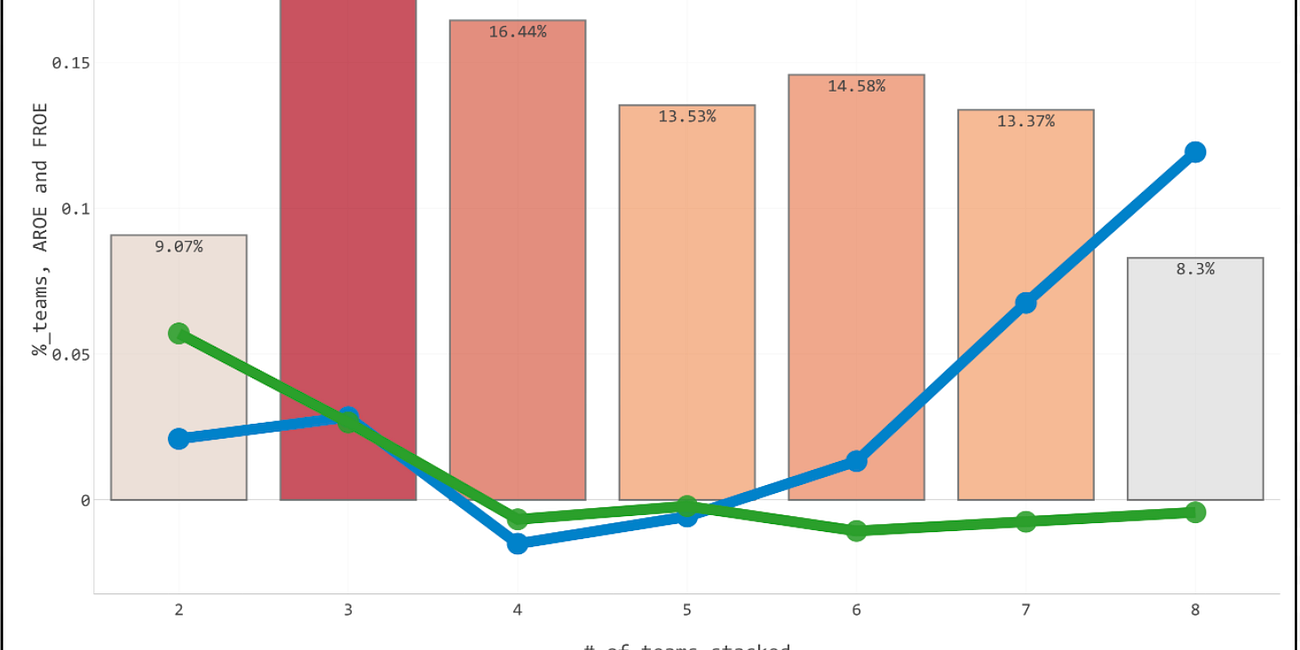Building Your Pennant Portfolio
How to put together the right Pennant Portfolio for you
Ross Stripling may not be pitching in the postseason this year (or last year, RIP 2022 Blue Jays) but he should be your inspiration for this year’s contest. In addition to being a major league pitcher, Ross Stripling is also a Managing Partner at Skyward Financial - a wealth management firm. Ross looks like a trustworthy guy and someone who knows how to build a nice portfolio, he’d probably appreciate our strategy for the Pennant. The headshot/banner for the website were simply too funny for me to ignore and so I’ve shoehorned this Ross Stripling tangent into today’s article.
When the Pennant first opened, I started by looking at the highest-level macro trends from the 2022 contest - if you haven’t read that already, I recommend starting there as this piece will build off of the foundation laid there:
The 2022 Pennant - Data Analysis and Observations
The Pennant is Underdog’s playoff MLB Best Ball contest, it is my favourite contest of the year and in my opinion, it is the least understood and worst played best ball tournament I’ve entered on Underdog. You can find the full rules set linked here (
I summarized my main findings into the following rules of thumb that I’m planning to use this year:
Stacking 2 teams is ideal, 3 is okay, 4+ is bad
If you stack 3 teams, take 2 or fewer players from the 3rd team
Drafting 5 pitchers is ideal, 4 or 6 is good, everything else is bad
Drafting 4-7 bye team players is ideal, 1-3 is fine and 8+ are bad
Draft at any point during the contest life, but save some bullets for the last week
While I do believe that understanding structure and the macro data available to us, we also need to be able to apply it prospectively in the upcoming contest in order to win some money. My goal today is to start bridging that gap by taking our overarching rules and layering on some additional thoughts about portfolio-based drafting and how to approach this year’s Pennant. My plan in the coming weeks is to get more micro in my analysis and start honing in on the specific edges we should be trying to push within this year’s contest. Subscribe to Stacking Dingers in order to get more Pennant content coming your way over the next month as we close in on the postseason!
Portfolio Based Drafting
Best ball gives us the opportunity to do the most fun part of fantasy sports over and over again, with no ongoing entanglement or time investment on a weekly basis. With lower average buy-ins and a higher volume of teams available to draft, best ball requires a portfolio-based drafting mindset more than your average fantasy team. Playoff best ball takes your regular best ball mindset and turns it up to 11.
Your goal when entering any contest should be the following:
How do I turn my $X entry fees into $LotsMoreThanX winnings?
With playoff best ball, every entry is an opportunity to build your portfolio and every pick has an opportunity cost. We don’t want to waste either of those. Every pick in every draft has to be aimed at contributing to you making money overall in the contest. With the top heavy payout structure, we want as many live shots at 1st place as possible.
As we learned earlier on, stacking 2 teams last year was under utilized by the field and produced outsized returns - so we want to lean on that again this year. In order to simply and effectively track your exposures, I recommend setting up a table in your favourite spreadsheet software (or on in the Notes app on your phone) to track the number of times you’ve drafted each specific combination of an AL team vs. NL team in the World Series. For example, through 150 drafts mine looks like this:
My thought process behind these exposures and how/why the fuck I decided to draft 150 Pennants in the first 10 days of the contest will be coming next week!
The grid gives you a simple, straightforward bird’s eye view on your current portfolio of potential World Series matchups along with how often you’ve drafted them. From mine, you can see that I’m heavy on combos of ATL or LAD with an AL wild card team and light on anything beyond one of ATL/LAD/MIL/PHI making the WS from the NL. I use this table every time I draft a team, and log when I’m making a new stack - it takes 10 seconds and will save you an enormous amount of time when trying to balance/build the portfolio later on. The other thing I’ll do right away is name the team I’ve drafted - this will help later on when you need to quickly find a build in order to not dupe yourself or create some leverage on the field.
Leveraging Your Portfolio Based on Bankroll Size
When considering how to approach the Pennant from a portfolio-based drafting perspective my most important rule would be the following:
The number of teams and World Series matchups you include in your portfolio should be directly proportional to the number of entries you plan to draft in the Pennant.
In other words:
If you’re planning on entering a lower number of teams (think 10-25ish), you should be thinking about narrowing down the pool of possible MLB teams/WS matchups you’ll have in your portfolio and then diversifying your individual drafts within that narrow pool of matchups.
Diversifying your Pennant portfolio requires a mix of breadth and depth:
Breadth = the # of different MLB teams you include in your pool
Depth = the # of different players you include from each of those teams
Getting this mix right is tough to do perfectly, but can be beneficial to have in mind when powering through drafts. I would much rather that you have multiple live shots in the final if you predict the matchup correctly than a few meh options for every conceivable scenario you can think of. With limited entry capital, you have to choose between having a thin shot at covering all your bases or a real shot at a narrow range of outcomes. For most people, I think the latter is a more realistic way to profit in this contest.
This is an example of a World Series Matchup decision tree that can help you organize your thoughts and build a plan of attack for the Pennant. This is not the perfect solution, or specifically what I’m using to build my portfolio - it’s just an example of a helpful tool that I use myself when trying to stay organized.
If you’re planning on drafting a higher volume of teams (think >100 teams), you can go both directions:
Either expand the pool (breadth) of MLB teams/WS matchups you include OR
Adopt a narrower pool (similar to above) and focus on hitting those matchups from every conceivable angle (depth)
Building out the depth of your stacks is a good way to differentiate when you have narrowed in on a team in your draft. This is especially important when targeting the non-ADP costly teams, especially when matched up with each other. For example, if you’re drafting multiple PHI-SEA World Series teams you should start mixing in different Phillies and Mariners into those stacks to add texture and variety. PHI is one of the easier teams to load up on the nut stack (the top 6 players from a team) and then move on to your AL matchup. At least it was until Tuma wrote up the Phillies earlier:
Your Goal Today Is to Draft a Phillies Stack in the Pennant
Just as a reminder, before continuing this article, that if you haven’t done so already then you need to read Chris’ manifesto on last year’s MLB playoff Best Ball tournament. Doing so should be considered “table stakes” before even entering the contest.
However, once you’ve landed that nut stack in a matchup once you probably shouldn’t try to dupe yourself (getting the exact same 12 players on a team) by trying to land it again just because of ADP or projections. Playoff ADPs are among the least actionable and important of all the ADPs on Underdog. I made a conscious effort this year to mix up my combos on the back end of my teams, even when the top stack feels great. Having those low owned differentiators in the final could be the small difference between a large group of very similar teams.
Before getting too deep into Pennant drafting, I really think laying out your overall strategy and tracking plan is a good idea that everyone should try to do. Staying organized when dealing with building a portfolio of stacks is 90% of the battle and setting yourself up for success is important.
Next week, I’ll write up my overall strategy for this year’s version of the contest and breakdown my exposures - its going to be fun. Doing 150 drafts already was certainly an idea, and I already have regrets (and some benefits) to share. Enjoy your weekend everyone (and Week 1 too).







